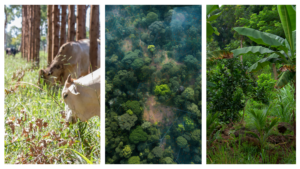Approaches to sustainability in Brazilian agriculture: Combining environmental conservation with economic growth
PlanaFlor, a unique and strategic plan for implementing the Forest Code, stands out as it complements Brazil’s recently launched National Programme for Converting Degraded Pastures (PNCPD). This alignment is not just crucial, it’s a game-changer, ensuring that the broad goals set by the PNCPD for pasture recovery are not just met, but exceeded. PlanaFlor’s detailed actions for achieving strategic objectives within its holistic approach further reinforce the government’s vision for transitioning to sustainable agriculture that fosters economic growth, instilling confidence in the programme’s effectiveness.
In December 2023, Brazil’s Ministry of Agriculture and Livestock (MAPA) announced the launch of the National Program for Converting Degraded Pastures into Sustainable Agricultural and Forestry Systems (PNCPD). The program aims to recover and convert up to 40 million hectares (Mha) of degraded pastures over ten years. This goal exceeds the targets set by previous plans, including Brazil’s Nationally Determined Contribution (NDC) under the Paris Agreement, underscoring the urgency of addressing environmental impacts from degraded pastures while meeting the growing demand for agricultural products and meat. The conversion process involves a series of steps, including soil restoration, reforestation, and the introduction of sustainable farming practices. Without increased productivity, projections indicate that deforestation would be needed to meet the growing demand for beef, pressuring forested areas.
According to MAPA projections, Brazil’s agriculture will require an additional 11.3 Mha of land by 2030/31, and meat production will increase by 17% from 2020/21 to 2030/31. Without productivity gains, about 7 Mha of new deforestation would be required to meet the meat demand. PlanaFlor aligns with PNCPD’s focus on recovering degraded pastures and outlines 104 actions to achieve eight strategic goals. These actions promote sustainable development by implementing the Forest Code, strengthening government institutions, expanding agriculture without deforestation, supporting low-carbon agriculture, conserving forest remnants, and restructuring credit systems to promote these objectives. This alignment with Brazil’s environmental and climate goals reassures us of the proposal’s effectiveness in addressing the pressing issues of our time.
PlanaFlor identifies about 75 Mha of degraded pastures in Brazil and proposes recovering and converting approximately 44 Mha by 2030. Around 12 Mha would be converted for agriculture, aligning with MAPA’s projected growth by 2030/31. The remaining land would be used for various purposes, including agroforestry, low-carbon agriculture, and the restoration of native vegetation.
To meet these goals, PlanaFlor emphasises the importance of incentives to maintain existing native vegetation, which plays a crucial role in sustainable rural development. Despite Brazil’s strict Forest Code, which mandates conservation in private lands, PlanaFlor estimates that approximately 110 Mha of conserved native vegetation in private areas exceeds the legal requirements. About half of this could be legally deforested, raising the need for public policies and private investments to keep these areas intact. The success of these policies and investments relies on the active participation of the private sector and international cooperation, underscoring the collaborative nature of PlanaFlor and the need for collective action in achieving its goals.
PlanaFlor’s approach to addressing illegal deforestation through increased monitoring and data integration and suggesting that legal deforestation be reduced through environmental asset valuation and economic incentives, is not just about environmental conservation. It’s about unlocking significant economic growth potential. The plan’s modelling shows that by implementing the Forest Code, the proposed land-use changes could substantially boost Brazil’s GDP, with an estimated increase of about R$6.5 billion annually and a total economic movement of over R$400 billion by 2030. This economic optimism is a key aspect of PlanaFlor’s appeal.
In addition to economic benefits, PlanaFlor’s approach could lead to significant social and environmental gains. These include strengthening family farming, creating 2.5 million new jobs, recovering 31 Mha of degraded pastures, and conserving 110 Mha of native vegetation. Moreover, the plan’s carbon sequestration efforts could result in storing or avoiding the emission of over 25 Gt of CO2eq, contributing to Brazil’s climate goals under the Paris Agreement.
Ultimately, PlanaFlor demonstrates that environmental conservation and economic growth are not in conflict but can drive each other, positioning it as a sustainable agriculture and forest conservation model that can be replicated worldwide.

